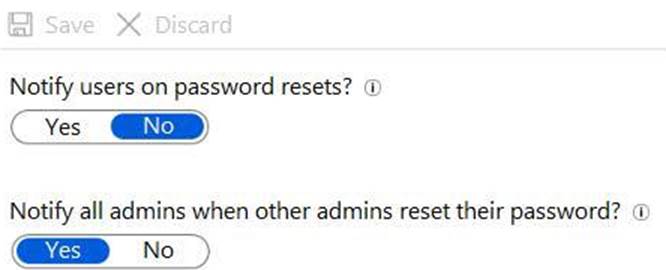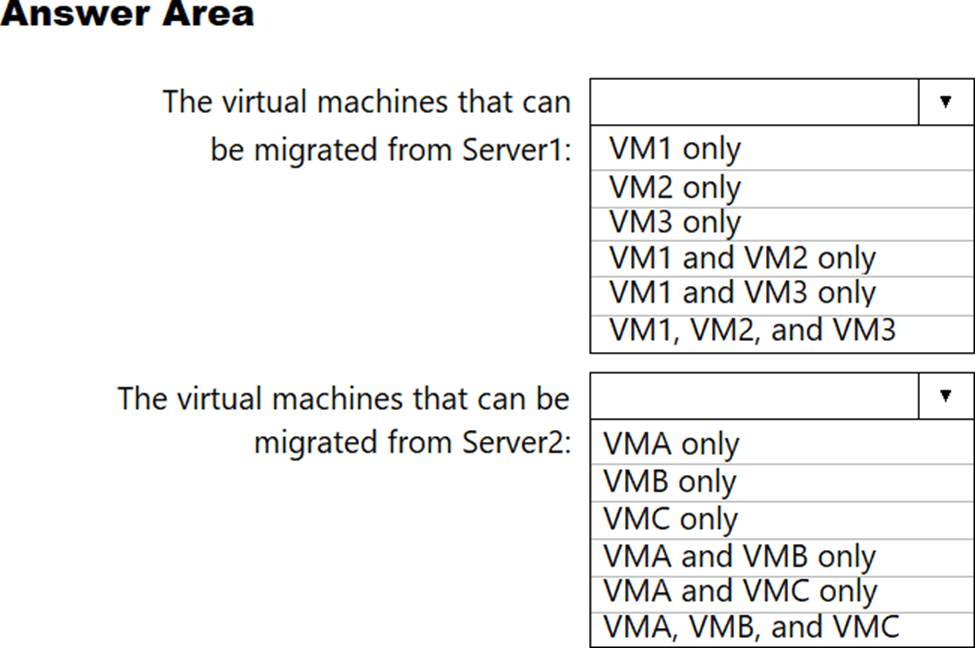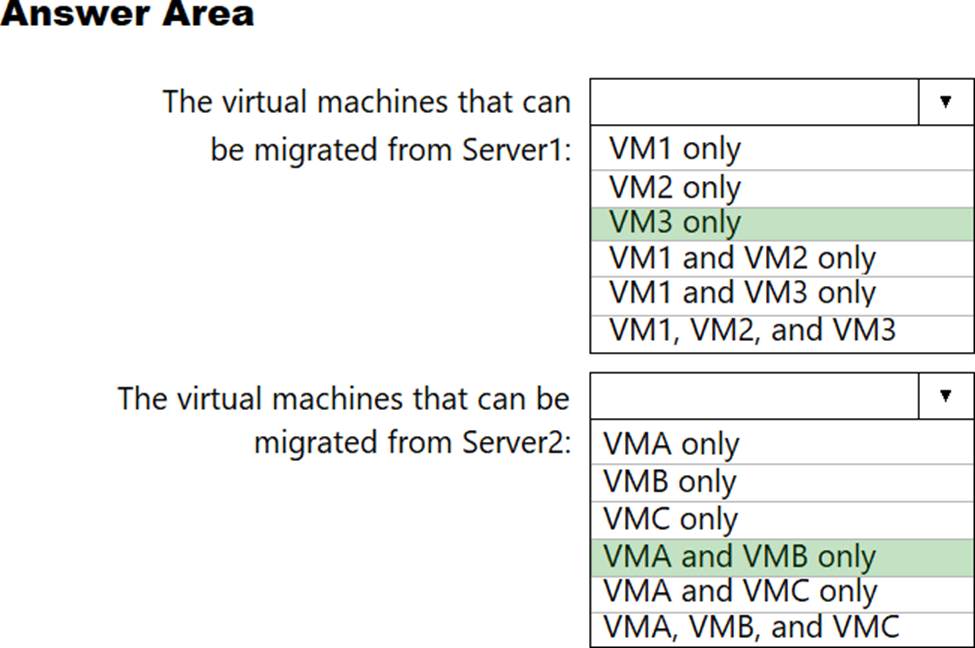Microsoft AZ-303 Microsoft Azure Architect Technologies Online Training
Microsoft AZ-303 Online Training
The questions for AZ-303 were last updated at Dec 25,2025.
- Exam Code: AZ-303
- Exam Name: Microsoft Azure Architect Technologies
- Certification Provider: Microsoft
- Latest update: Dec 25,2025
HOTSPOT
You have an Azure Active Directory (Azure AD) tenant that contains the user groups shown in the following table.

You enable self-service password reset (SSPR) for Group1.
You configure the Notifications settings as shown in the following exhibit.

For each of the following statements, select Yes if the statement is true. Otherwise, select No. NOTE: Each correct selection is worth one point.

DRAG DROP
You have virtual machines (VMs) that run a mission-critical application.
You need to minimize the possibility that the application will experience downtime.
What should you recommend? To answer, drag the appropriate solutions to the correct scenarios. Each solution may be used once, more than once, or not at all. You may need to drag the split bar between panes or scroll to view content. NOTE: Each correct selection is worth one point.

Note: This question is part of a series of questions that present the same scenario. Each question in the series contains a unique solution that might meet the stated goals. Some question sets might have more than one correct solution, while others might not have a correct solution.
After you answer a question in this section, you will NOT be able to return to it. As a result, these questions will not appear in the review screen.
Your company is deploying an on-premises application named Appl. Users will access App1 by using a URL of https://app1.contoso.com. You register App1 in Azure Active Directory (Azure AD) and publish Appl by using the Azure AD Application Proxy. You need to ensure that Appl appears in the My Apps portal for all the users.
Solution: You create an offer for App1 and publish the offer to Azure Marketplace.
- A . Yes
- B . No
HOTSPOT
Your company has a virtualization environment that contains the virtualization hosts shown in the following table.

The virtual machines are configured as shown in the following table.

All the virtual machines use basic disks. VM1 is protected by using BitLocker Drive Encryption (BitLocker).
You plan to migrate the virtual machines to Azure by using Azure Site Recovery.
You need to identify which virtual machines can be migrated.
Which virtual machines should you identify for each server? To answer, select the appropriate options in the answer area. NOTE: Each correct selection is worth one point.

You have an Azure web app that runs in a Premium App Service plan.
Developers plan to update the app weekly.
You need to ensure that the app can be twitched from the current version to the new version.
The solution must meet the following requirements:
• Provide the developers with the ability to test the app m Azure prior to switching versions Testing must use the same app instance
• Ensure that the app version can be rolled back.
• Minimize downtime.
What should you do?
- A . Create a deployment slot.
- B . Add an instance of the app to the scale set
- C . Copy the App Service plan.
- D . Create an Azure Active Directory (Azure AD) enterprise application
Note: This question is part of series of questions that present the same scenario. Each question in the series contains a unique solution that might meet the stated goals. Some question sets might have more than one correct solution, while others might not have a correct solution.
After you answer a question in this section, you will NOT be able to return to it. As a result, these questions will not appear in the review screen.
You have a server named Server1 that runs Windows Server 2019. Server1 is a container host.
You are creating a Dockerfile to build a container image.
You need to add a file named File1.txt from Server1 to a folder named C:Folder1 in the container image.
Solution: You add the following line to the Dockerfile.
COPY File1.txt C:/Folder1/
You then build the container image.
Does this meet the goal?
- A . Yes
- B . No
You have an Azure subscription that contains 20 virtual machines. The virtual machines require authenticated access to several Azure resources.
You need to ensure that the virtual machines can authenticate by using Azure Active Directory (Azure AD).
Solution: You configure the Identity settings for each virtual machine.
Does this meet the goal?
- A . Yes
- B . No
You have the following Azure Active Directory (Azure AD) tenants
• Contosoonmicrosoft.com Linked to a Microsoft Office 365 tenant and syncs to an Active Directory forest named contoso.com by using password hash synchronization
• Contosoazure onmicrosoft.com Linked to an Azure subscription named Subscription1.
You need to ensure that you can assign the users in contoso.com access to the resources in Subscription1.
What should you do?
- A . Configure contosoxHVTttcrosoft.com to use pass-through authentication.
- B . Associate Subscription1 to contoso.onmicrosoft.com Reassign all the roles in Subscnption1.
- C . Deploy a second Azure AD Connect server and sync contoso.com to contosoazure.onmicrosoft.com.
- D . Configure Active Directory federation Services (AD FS) federation between contosoazure.onmicrosoft.com and contoso.com.
You have an Azure subscription named Subscription1.
You create several Azure virtual machines in Subscription1. All of the virtual machines belong to the same virtual network.
You have an on-premises Hyper-V server named Server1. Server1 hosts a virtual machine named VM1.
You plan to replicate VM1 to Azure.
You need to create additional objects in Subscription1 to support the planned deployment.
Which three objects should you create? Each correct answer presents part of the solution. NOTE: Each correct selection is worth one point.
- A . Hyper-V site
- B . Azure Recovery Services Vault
- C . storage account
- D . replication policy
- E . Azure Traffic Manager instance
- F . endpoint
You have resources in three Azure regions. Each region contains two virtual machines. Each virtual machine has a public IP address assigned to its network interface and a locally installed application named App1.
You plan to implement Azure Front Door-based load balancing across all the virtual machines.
You need to ensure that App1 on the virtual machines will only accept traffic routed from Azure Front Door.
What should you implement?
- A . Azure Private Link
- B . service endpoints
- C . network security groups (NSGs) with service tags
- D . network security groups (NSGs) with application security groups
Latest AZ-303 Dumps Valid Version with 206 Q&As
Latest And Valid Q&A | Instant Download | Once Fail, Full Refund




